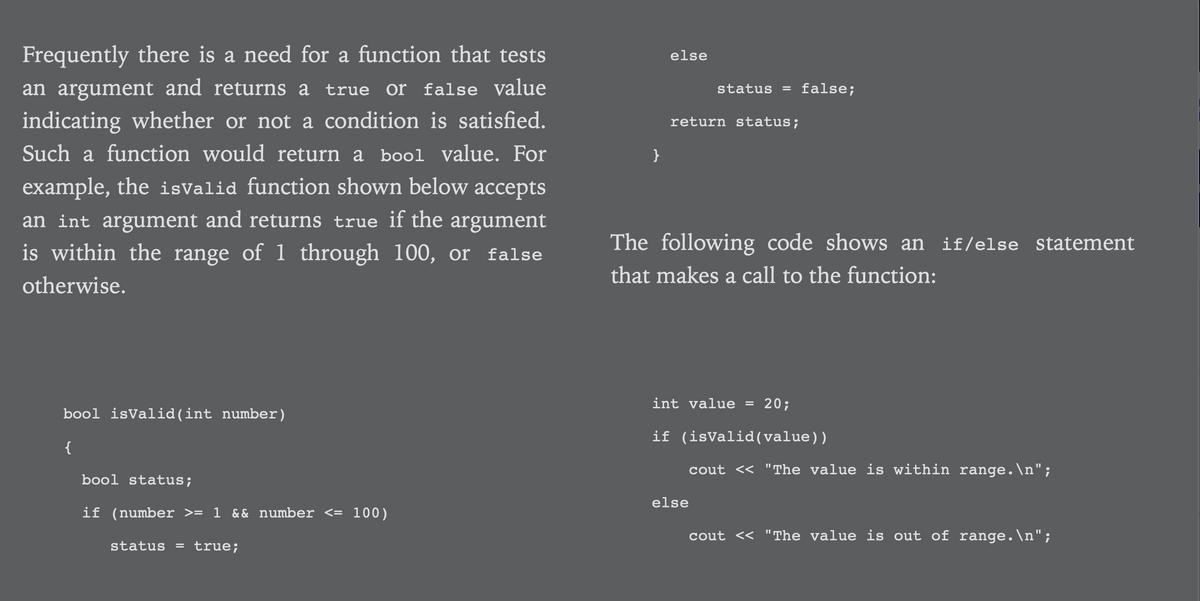Frequently there is a need for a function that tests else an argument and returns a true or false Value status = false; indicating whether or not a condition is satisfied. return status; Such a function would return a bool value. For example, the isValid function shown below accepts an int argument and returns true if the argument is within the range of 1 through 100, or false The following code shows an if/else statement that makes a call to the function: otherwise. int value = 20; bool isValid(int number) if (isValid(value)) { cout « "The value is within range.\n"; bool status; else if (number >= 1 && number <= 100) cout << "The value is out of range. \n"; status = true;
Frequently there is a need for a function that tests else an argument and returns a true or false Value status = false; indicating whether or not a condition is satisfied. return status; Such a function would return a bool value. For example, the isValid function shown below accepts an int argument and returns true if the argument is within the range of 1 through 100, or false The following code shows an if/else statement that makes a call to the function: otherwise. int value = 20; bool isValid(int number) if (isValid(value)) { cout « "The value is within range.\n"; bool status; else if (number >= 1 && number <= 100) cout << "The value is out of range. \n"; status = true;
Database System Concepts
7th Edition
ISBN:9780078022159
Author:Abraham Silberschatz Professor, Henry F. Korth, S. Sudarshan
Publisher:Abraham Silberschatz Professor, Henry F. Korth, S. Sudarshan
Chapter1: Introduction
Section: Chapter Questions
Problem 1PE
Related questions
Question
I am learning c++, and I am really confused about the bool command. Please explain to me how the bool command used and when should I use it! thanks.

Transcribed Image Text:Frequently there is a need for a function that tests
else
an argument and returns a true or false value
false;
status =
indicating whether or not a condition is satisfied.
return status;
Such a function would return a bool value. For
}
example, the isValid function shown below accepts
an int argument and returns true if the argument
is within the range of 1 through 100, or false
The following code shows an if/else statement
that makes a call to the function:
otherwise.
int value
20;
bool isValid (int number)
if (isValid(value))
{
cout <« "The value is within range.\n";
bool status;
else
if (number >= 1 && number <= 100)
cout << "The value is out of range.\n";
status
true;
Expert Solution
Step 1
the answer is
Trending now
This is a popular solution!
Step by step
Solved in 4 steps with 1 images

Knowledge Booster
Learn more about
Need a deep-dive on the concept behind this application? Look no further. Learn more about this topic, computer-science and related others by exploring similar questions and additional content below.Recommended textbooks for you

Database System Concepts
Computer Science
ISBN:
9780078022159
Author:
Abraham Silberschatz Professor, Henry F. Korth, S. Sudarshan
Publisher:
McGraw-Hill Education

Starting Out with Python (4th Edition)
Computer Science
ISBN:
9780134444321
Author:
Tony Gaddis
Publisher:
PEARSON

Digital Fundamentals (11th Edition)
Computer Science
ISBN:
9780132737968
Author:
Thomas L. Floyd
Publisher:
PEARSON

Database System Concepts
Computer Science
ISBN:
9780078022159
Author:
Abraham Silberschatz Professor, Henry F. Korth, S. Sudarshan
Publisher:
McGraw-Hill Education

Starting Out with Python (4th Edition)
Computer Science
ISBN:
9780134444321
Author:
Tony Gaddis
Publisher:
PEARSON

Digital Fundamentals (11th Edition)
Computer Science
ISBN:
9780132737968
Author:
Thomas L. Floyd
Publisher:
PEARSON

C How to Program (8th Edition)
Computer Science
ISBN:
9780133976892
Author:
Paul J. Deitel, Harvey Deitel
Publisher:
PEARSON

Database Systems: Design, Implementation, & Manag…
Computer Science
ISBN:
9781337627900
Author:
Carlos Coronel, Steven Morris
Publisher:
Cengage Learning

Programmable Logic Controllers
Computer Science
ISBN:
9780073373843
Author:
Frank D. Petruzella
Publisher:
McGraw-Hill Education